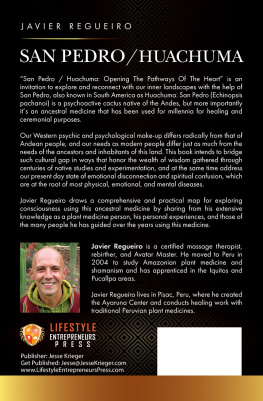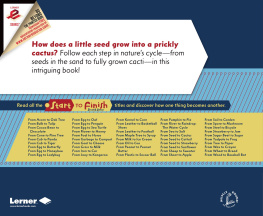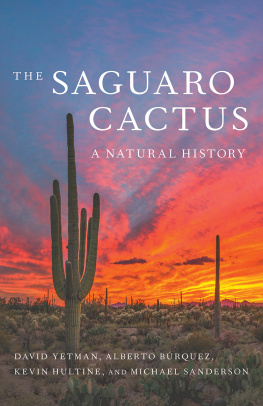For the Sarah I knew then: Echo en falta que la mayora de todos skank-ho. Fuma y agua; amor para siempre. Y el Sarah ahora? No le conozca.
For those who contributed. For Darryl, Bobby, Suzie, Emily, and Jeannie ~ who kept the faith and fire alight during darker nights. For Teertha, Tania, Sue, and Emily ~ for new adventures. For my children.
CACTUS OF
MYSTERY

An amiable, intelligent, and passionate introduction to the sacred medicine of the Andes. Ross Heavens Cactus of Mystery is valuable not only as an orientation toward the ancient Huachuma tradition but also as an exploration of the experiences of healing and creativity common to all sacred medicine traditions.
ROBERT TINDALL, AUTHOR OFTHE JAGUAR THAT ROAMS
THE MIND AND THE SHAMANIC ODYSSEY
Contents
INTRODUCTION
The Mystery of San Pedro

Ross Heaven
If you are reading this book you are in a privileged minority, for almost nothing has been written about San Pedro or its use in shamanism and healing. Before my 2009 book The Hummingbirds Journey to God, there was little information available on it at all apart from scattered references in a few other works. Trouts Notes on San Pedro (Mydriatic Productions, 2005), for example, is a study of the botany, chemistry, and history of the plant, but does not address its shamanic uses. One of the more useful books in the latter regard is Douglas Sharons Wizard of the Four Winds: A Shamans Story (Free Press, 1978), but this has its limitations also because it is more or less the story of a single individual (the books subtitle suggests as much), Eduardo Calderon, an Andean healer whom Sharon worked with for a few seasons some decades ago. As such it focuses on one healer operating within the traditions of one part of Peru (the north) and is a study of curanderismo (Andean healing) in general rather than San Pedro, per se. A further limitation is that the book has been out of print for many years and is hard to come by, with copies on the web often selling for a hundred dollars or more.
A Google search will not help much either, yielding next to nothing useful for students of shamanism or San Pedro, apart from a few articles and interviews mostly stemming from me.
Frankly, I am amazed that so little research has been done on San Pedro, its effects, or its applications for healing, especially since the latter are, in my experience, real and profound.
I have worked with the plant since the late 1990s and increasingly so in the past decade, during which time I have also taken groups of people to Peru so they can drink it themselves. I have witnessed firsthand what some of the shamans in this book refer to as healing miracles during the course of these journeys, and seen people cured of cancer, depression, grief, childhood traumas, alcoholism, diabetes, and other debilitating and sometimes life-threatening diseases. And yet there is still almost nothing published about this plant.
WHY?
At least in part this lack of information is a reflection of the fact that the most ancient healing traditions of Peru, like those of other pre-Christian cultures, are transmitted orally. Not much is ever written down by shamans so where records do exist they have tended to be made by European explorers, invaders, or missionaries who have brought their religious beliefs with them and denigrated indigenous practices that did not sit well with their own notions of God.
As professor of cultural anthropology Irene Silverblatt put it, History making (which includes history denying) is a cultural invention.... History tends to be made by those who dominate... to celebrate their heroes and silence dissent.
Another, Father Olivia, part of a seventeenth-century-church-sponsored scheme to extirpate idolatries, wrote in 1631 that after they drink it they [participants in San Pedro ceremonies] remain without judgment and deprived of their senses and they see visions that the Devil represents to them and consistent with them they judge their suspicions and the intentions of others.
Fundamentalism like this never results in any pure or useful critique and, as Jim DeKorne remarks in Psychedelic Shamanism (Breakout Productions, 1994), rather than trying to understand native customs:
The Spanish Inquisition reacted with characteristic savagery to anyone who dared to break their laws by eating [sic] [San Pedro]... a great many Indians were flogged and sometimes killed when they persisted in [doing so].... [One mans] eyeballs were said to be gouged out after three days of torture; then the Spaniards cut a crucifix pattern in his belly and turned ravenous dogs loose on his innards.... This level of response to the ingestion of... San Pedro in Peru effectively drove the use of [the cactus] underground for hundreds of years.
Even the name of the plant owes more to Catholicism than the shamanic traditions of the Andes, for the cactus (originally known as huachuma) was, as DeKorne relates, renamed after Saint Peter, guardian of the threshold for the Catholic Paradise... an apparent strategy of the Indians to placate the Inquisition.
Juan Navarro, with whom I drank San Pedro in the 1990s, may be suggesting something along these lines as well when, in my book Plant Spirit Shamanism (Destiny Books, 2006), he remarks that San Pedro retains a certain mystery to it.
Navarros ceremonies are performed at night from a mesa (altar), which contains many Catholic symbols, crosses, staffs, rosaries, icons, and lithographs of the Christian saints. This may be a form of syncretism but most likely is also a sort of mask that draws attention away from the way that things were originally done within the San Pedro tradition. When Navarro performs a ceremony, for example, he prays to God, the saints, the Virgin, and to Jesus and he holds a cross aloft, but I have no doubt that these emblems have a different meaning to him than to us. Some anthropologists suggest that the Virgin of Guadalupe, whose image is ubiquitous in Andean healing rituals, is in fact a Christianized version of the Aztec lunar goddess Tonantzin, so whomever Navarro is praying to is most likely not the same Holy Virgin we know.
These historic considerations have been pushed aside in recent times, however, certainly by the shamans I know and work with in the Andes, who seem keen to lift the veils of secrecy surrounding San Pedro. The feeling among these shamans (some of whom have written for this book or been interviewed in its pages) is that the time for greater openness about this medicine is now, because we are entering a period of great change and its healing is needed more than ever before.
The feeling seems mutual among the scientific profession as well, and a number of academics are also beginning to look again (or for the first time) at San Pedro and the role it may play in healing, ESP, precognition, and other extrapersonal and transpersonal states. David Luke, Ph.D., is one such academicin this book he examines the potential of San Pedro in this regard and reports on an intriguing experiment of his own.
But lets start with the basics. What exactly is San Pedro and what do we know of its usage?











